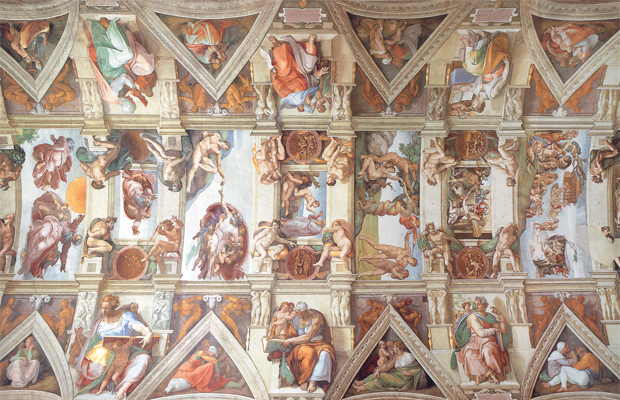
Behind the scenes at The Art Museum
The hand that bites the master
Among Michelangelo’s impressive array of enemies was Pope Julius II and the Catholic Church itself. In fact, when commissioned to paint the ceiling of the Sistine Chapel, which was already covered by an emulated starry sky, he suspected Pope Julius II of trying to publicly embarrass him by showing his painting skills to be inferior to those of contemporaries such as Raphael. He tried to turn down the commission completely, with no success. During the work, the pope came in to see how it was all going; Michelangelo responded by hurling planks from the scaffolding he was working on down at him. After the pope responded by beating him in public, Michelangelo took instead to taking out his anger in more subtle, but ultimately more enduring, ways.
The Last Judgement (which can be found in galleries 183/4 of The Art Museum) depicts the damned souls descending through the mouth of Hell, while Christ saves the chosen few. The mouth of Hell itself just happens to be depicted behind the papal seat itself; a decision which many have interpreted as being a subtle commentary on the corruption of the papacy. A less subtle commentary can be found in one of the ceiling’s spandrels, which includes a portrait of Pope Julius II (otherwise known as Il Papa Terribile) himself, in the guise of the prophet Zachariah. Behind this figure’s back is a charming cherub making a not-so-charming hand gesture at the pope’s head. Known as ‘The Fig’, it involves placing one’s thumb between one’s second and third finger, and was the Renaissance equivalent of sticking two fingers up. Michelangelo appears to have gambled on the gesture being lost among the buzzing activity of the ceiling design; a gamble which paid off, as he continued to receive papal commissions long after this.
Michelangelo makes another use of figs in The Temptation, where the Tree of Knowledge is depicted not as the traditional apple tree, but as a fig tree. This has been claimed by some to be a dismissal of the Christian Bible interpretation in favour of older, Judaic interpretations, where the Tree of Knowledge is most commonly depicted as a fig tree. Michelangelo had many good reasons to hate the Catholic Church; one of them was the Counter-reformation’s aversion to Classical nudity, which was revising much of its cultural heritage by covering up these nude bodies – with fig leaves.